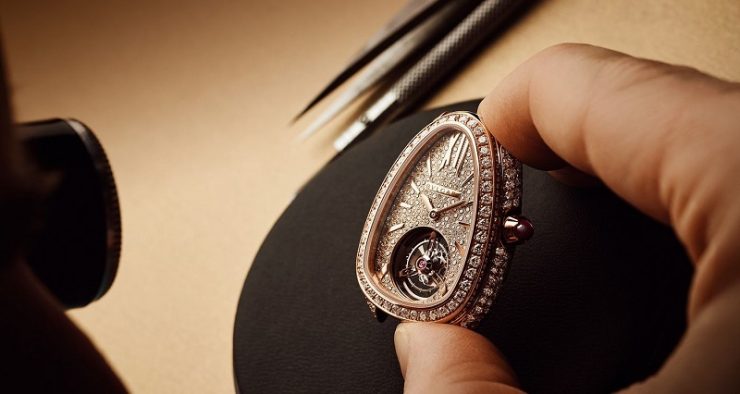THE recent’s exhibition of LVMH Watch Week Dubai 2020 watches is marked by the launch of Bvlgari’s amazing new collection, including the Serpenti Seduttori Tourbillon watch, the world’s smallest women’s tourbillon watch that is unique and specially designed to match the sleek dimensions of the snake head case from the iconic Serpenti line, and of course some of the latest versions of the Diva’s Dream women’s watch line.
Over the last few years, Bulgari has become, quite remarkably, not just one of the world’s leading jewelry houses, but one of its leading watchmakers as well. Record after record – some of which have stood for decades – have fallen to its new introductions.
Bulgari now boasts the world’s thinnest tourbillon – which is also the world’s thinnest automatic movement – the world’s thinnest time-only automatic movement, and the world’s thinnest automatic chronograph. The latest record the company has set, is also in miniaturized watchmaking: the hand-wound tourbillon movement, caliber BVL150, in the newly introduced Serpenti Seduttori Tourbillon, is the smallest tourbillon, overall, in current production.
The movement is remarkably small. Dimensions overall, are 22mm x 18mm and the caliber is 3.65mm thick; the tourbillon cage is 10.88mm in diameter. As far as I am aware, the smallest diameter tourbillon movement ever made was a bit smaller – it was made by Fritz-André Robert-Charrue, of Le Locle, and completed in 1945. This was a round movement with a diameter of 19.7mm, and an 8mm cage.
Robert-Charru was a famous master taught by a famous master. He was apprenticed to James Pellaton, one of the most well known tourbillon makers of the 20th century, who had made the previous record-holder which was another round tourbillon watch, with a movement diameter of 23.6mm, which was completed in 1927.
As George Daniels pointed out in the chapter on movement design, in Watchmaking, there is actually something of a theoretical rationale for making the carriage as small as possible – one of the disadvantages of the tourbillon, is that every time the escapement unlocks, the train has to drive, not just the balance wheel, but all of the regulating components (balance, spring, lever, and escape wheel) as well as the mass of the carriage that carries them.
It is for this reason that the tourbillon fascinated the greatest watchmakers – the additional energy required for the tourbillon, in comparison with a conventional watch, means that in order for a tourbillon to work it must be constructed to a very high standard, and with a high degree of precision.
It is in this context that Bulgari’s achievement, and what it represents, can best be appreciated. The caliber BVL150, which took two years to develop, is unusual on several counts. First, there is its size – as we’ve seen, tourbillon movements this small are very thin on the ground, with production numbers, historically, in the single digits which is rather amazing.
Moreover, Bulgari, thanks to modern precision fabrication methods such as wire erosion, which were not available to Robert-Charrue, Pellaton, Guinand, and others, and also thanks to clever engineering and good design, has been able to keep the movement dimensions small, while at the same time, using a tourbillon cage which is large enough to provide the visual effect which, after all, is the raison d’être of the whole enterprise.
Bulgari’s chief designer, Fabrizio Buonamassa, remarked by email that, The movement is so small that if we would had put a traditional bridge, we would have seen practically nothing. It’s one of the most wonderful pieces of traditional horology that I’ve seen in a long time. This sort of thing represents a centuries-long fascination on the part of watchmakers, with the art of miniaturization.
“Examples abound; Breguet, for instance, made a watch small enough to fit into a ring, which was also an alarm and which “rang” by poking the owner in the finger with a needle. For almost as long as watchmaking has existed, watchmakers vied to produce smaller and smaller movements and at its most extreme, ultra-thin and miniature watchmaking has produced some of the most historically important, and breathtaking of timepieces. For all that, it remains, sadly, a rather niche and underappreciated art,” Fabrizo said. [sources/photo special]
















